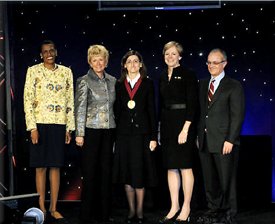Feb 22 2010
In Performance Polymers, Eleni Karayianni focused on changing the R&D process to increase the speed of developing new products. Her project set a paradigm-breaking precedent for seeking alternative approaches instead of continuing to do what has always been done. This approach resulted in 17 new patent filings in 2009.
 Eleni Karayianni (center) with DuPont leaders Jocelyn Scott, Diane Gulyas, Ellen Kullman and Jeff Keefer at the 2009 Excellence Awards ceremony.
Eleni Karayianni (center) with DuPont leaders Jocelyn Scott, Diane Gulyas, Ellen Kullman and Jeff Keefer at the 2009 Excellence Awards ceremony.
Developing new products is critical to Performance Polymers' business growth. However, the development process had not changed in 50 years. Traditionally, a few kilograms of a new formulation are produced on an R&D extruder and the granules are molded into test bars for lab analysis. Several formulations are produced per day, but scheduling conflicts in molding and test labs may delay results for weeks. The cycle of formulation and testing is repeated until the desired properties are attained.
Looking to accelerate the process, Eleni investigated ways to eliminate injection-molded test bars in developing new formulations, the slowest step. Believing it should be possible to produce test pieces directly from the R&D compounding extruder, she developed a Rapid Formulation Scouting System that extrudes a ribbon rather than pellets and then stamps out test bars from the ribbon.
Equipment improvements include micro-feeders that accurately measure different additive mixtures, making it possible to change additive levels in a dynamic manner and to predict the position of the changes in the extruded ribbon. This advance further accelerates formulation scouting - with continuous changes in additive level, every meter of ribbon effectively represents another experiment.
For low-smoke, halogen-free Hytrel flame-retardant resins (wire and cable coating), Eleni's system led to 35 new additive combinations in two days and test data in less than a month. Three iterations tested over 100 new additive combinations in less than three months, resulting in the development of at least two options that meet or exceed the target customer's performance criteria. A conventional process would have taken 18-24 months and would not allow as many additive combinations to be explored, resulting in less chance of being first to market with the best solution.
The potential business for low-smoke, halogen-free Hytrel is forecast to reach $80 million. Eleni's Rapid Formulation Scouting System has been successfully extended to Crastin and to other Performance Polymers' resins. In 2010, the system will be extended to the Shanghai lab.